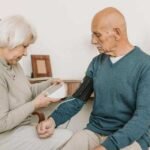
Nuclear Medicine Examination. Nuclear Stress Test. Uses, Instructions, Risks, and Procedures
What is Nuclear Stress Test?
Nuclear stress test (or myocardial perfusion scan) is a nuclear medicine cardiac diagnostic method (nuclear medicine examination).
The tester needs to inject radioactive isotopes orally or intravenously to take pictures of the heart through a gamma camera, such as a single-photon computed tomography (SPECT/CT) or a positron computed tomography (PET/CT). Blood flow images to observe whether there are problems such as insufficient blood supply or obstruction in the heart.
Differences in radioactive isotopes
Depending on the location of the test, nuclear medicine examinations are not limited to “nuclear stress test”. For example, if you want to check the patient’s thyroid gland, you may use iodine-131 (I-131) or iodine-131. Radioactive isotopes such as 99m (TC – 99m) for thyroid scans.
Back to the topic, in the diagnosis of coronary heart disease patients, the radioactive isotope that became widely used earlier was thallium-201 (Tl-201). However, the use of thallium-99m can obtain clearer images and the amount of radiation caused is relatively small. There is less, so Tuo-99m has become a radioactive material often used in nuclear medicine examinations.
Why perform a nuclear stress test?
Reasons why a physician may recommend a nuclear stress test include:
- If your doctor suspects that you are at risk for heart-related disease, such as coronary heart disease.
- Follow-up after angioplasty or cardiovascular bypass graft surgery.
- After a heart problem is diagnosed, nuclear stress test can also be used to assist with the progression of treatment.
- Help yourself understand the amount and intensity of exercise your heart can tolerate, which can be used to help choose the appropriate exercise method.
- Symptoms such as chest pain or shortness of breath that cannot be diagnosed with routine tests.
Things to know before nuclear stress test (or myocardial perfusion scan)
- Your doctor will discuss with you the appropriate time for a nuclear stress test.
- If you are pregnant or may be pregnant, please inform us in advance. Depending on the situation, it may not be appropriate to undergo the test.
- A treadmill or flywheel may be used during the examination, and it is recommended to wear athletic shoes.
- You need to start fasting 4 to 6 hours before the examination (you can drink water); avoid caffeinated foods and drinks within 24 hours before the examination.
- The daily medication list should be provided to the doctor, and the doctor should discuss with the doctor whether there are any medications that need to be suspended on the day of the examination. People with diabetes and/or taking other over-the-counter medications should take special care.
Risks of nuclear stress test (or myocardial perfusion scan)
Myocardial perfusion scans are performed by skilled, qualified professionals and are generally safe. The chance of a hazard occurring during an inspection is low, but known hazards include:
- Arrhythmias:
May be caused by exercise, but arrhythmias usually disappear after exercise stops and are rarely life-threatening. - Chest pain, dizziness:
In patients with severe heart disease, even moderate-intensity exercise may cause cardiac ischemia and other related symptoms. Although these symptoms can cause danger and discomfort, it is still necessary to induce and reproduce the symptoms through the process of myocardial perfusion scanning to confirm whether they are actually caused by coronary artery disease. - Allergic reaction:
Generally speaking, the radioactive isotope used in myocardial perfusion scan is not a contrast agent, so there is no problem of allergies to the contrast agent. However, a very small number of people may be allergic to radioactive isotopes. - Myocardial infarction:
The incidence rate is only 1/10,000. It usually occurs in people with severe coronary artery obstruction. Myocardial infarction occurs because the myocardial perfusion scan requires exercise. - Low blood pressure:
Some people may experience symptoms of low blood pressure and dizziness during or after exercise, but they usually recover after stopping exercise and resting for a while. - Other symptoms:
Other possible symptoms include nausea, palpitations, headaches, shortness of breath, etc. These symptoms may also be caused by drugs (which increase heart pressure instead of exercise). If you feel very uncomfortable, you can consider taking antagonists to improve it.
Who is not a good candidate for myocardial perfusion scanning
To minimize the risk of serious complications, people who meet the following conditions are not candidates for a nuclear stress test:
- Have irreversibly improved heart failure
- Have had a heart attack in the past 2 days
- Angina pectoris occurs from time to time
- Arrhythmias that are poorly controlled and can become life-threatening
- Have severe heart valve disease
- Have infective endocarditis
- Have acute aortic dissection
- Recent pulmonary embolism, or deep vein thrombosis
How is a nuclear stress test performed?
A nuclear stress test requires two examinations. Usually, a nuclear stress test is performed during exercise (stress state) in the morning, and a scan during rest (static) in the afternoon. Clear results can be obtained by comparing the difference between the two. .
In addition, myocardial perfusion scanning can be performed alone or in conjunction with other tests. The method used will vary depending on the type of heart disease.
Nuclear stress test process
Step 1
The doctor or examiner will first ask about your medical history, as well as your daily exercise habits and intensity, so as to choose an amount of exercise that can effectively stimulate your heart’s blood flow during the examination. Your doctor will also carefully examine your heart and lungs to rule out any abnormalities that may affect the test results.

Step 2
- First, the blood flow status under stress is detected, so you will be asked to use a treadmill or flywheel. In order to simultaneously monitor your blood pressure and breathing through an electrocardiogram, you must also wear electrode patches on your chest.
- You must continue to exercise until the exercise intensity increases to your maximum tolerance range, the preset time or goal is reached, abnormal patterns appear on the ECG, or symptoms occur.
- These symptoms include moderate to severe chest pain, severe shortness of breath, high or low blood pressure, irregular heartbeat, dizziness, etc. However, if you feel uncomfortable during the examination, you can also ask to stop the test at any time.
- For people who are not suitable for exercise, doctors will inject drugs into your veins that increase blood flow to the heart to simulate the impact of exercise on your heart. This drug may cause shortness of breath, flushed face and ears, similar to a reaction after exercise, but may cause side effects such as headache.
Step 3
After your heart rate reaches its peak, a nurse or examiner will slowly inject the radioactive isotope into your body through an intravenous injection. It is usually injected into the arm. You may feel the cold dye flowing slowly through the blood vessels in your arm. It takes about 20 to 40 minutes to reach your heart.
Step 4
The heart cells will absorb the imaging agent, and the doctor will observe whether there are any abnormalities during your recovery from exercise, such as whether your heartbeat and breathing can return to normal smoothly.
Step 5
After the stress examination, you need to rest for a few hours. During this period, you can drink water or eat white toast to relieve hunger (depending on the hospital’s regulations).
Step 6
In the afternoon, a resting nuclear stress test is performed. However, this time there is no need to exercise first. You only need to lie still in bed. After the radioactive isotope injected again enters the myocardial cells, you can obtain a resting blood flow image.
Step 7
Physicians make a diagnosis by comparing nuclear stress test during stress and rest.
After nuclear stress test
- Unless otherwise instructed by your doctor, you can resume your normal life after the examination is completed.
- Drinking plenty of water can help eliminate drugs and radioactive substances from the body.
- If you have any questions about myocardial perfusion scanning, please consult your physician.
Nuclear stress test results
The doctor will explain the results of the test. Possible results include:
- Blood flow is normal and no further testing is needed.
- Normal blood flow at rest but insufficient blood flow during exercise: Parts of the heart are not receiving enough blood, which may mean one or several arteries are blocked, or coronary artery disease.
- Insufficient blood flow at rest and during exercise: This means that part of the heart has been in a state of ischemia, and may have severe coronary artery disease or a previous heart attack.
- Radioisotopes do not reach certain parts of the heart: This indicates that the heart tissue in that area has been damaged, possibly from a previous heart attack.
If the blood flow to the heart is insufficient, a coronary angiography may be performed to allow the doctor to directly observe the blood vessels in the heart.
If the results show that the heart blood vessels are severely blocked, coronary intervention may be required, such as cardiac angioplasty (Angioplasty), which uses a balloon or stent to open the blood vessels, or coronary artery bypass surgery (Coronary artery bypass) to establish bypass blood vessels for maintenance. Coronary blood circulation.
Different laboratories and hospitals may have different definitions of normal values. If you have any questions, please consult your doctor.












